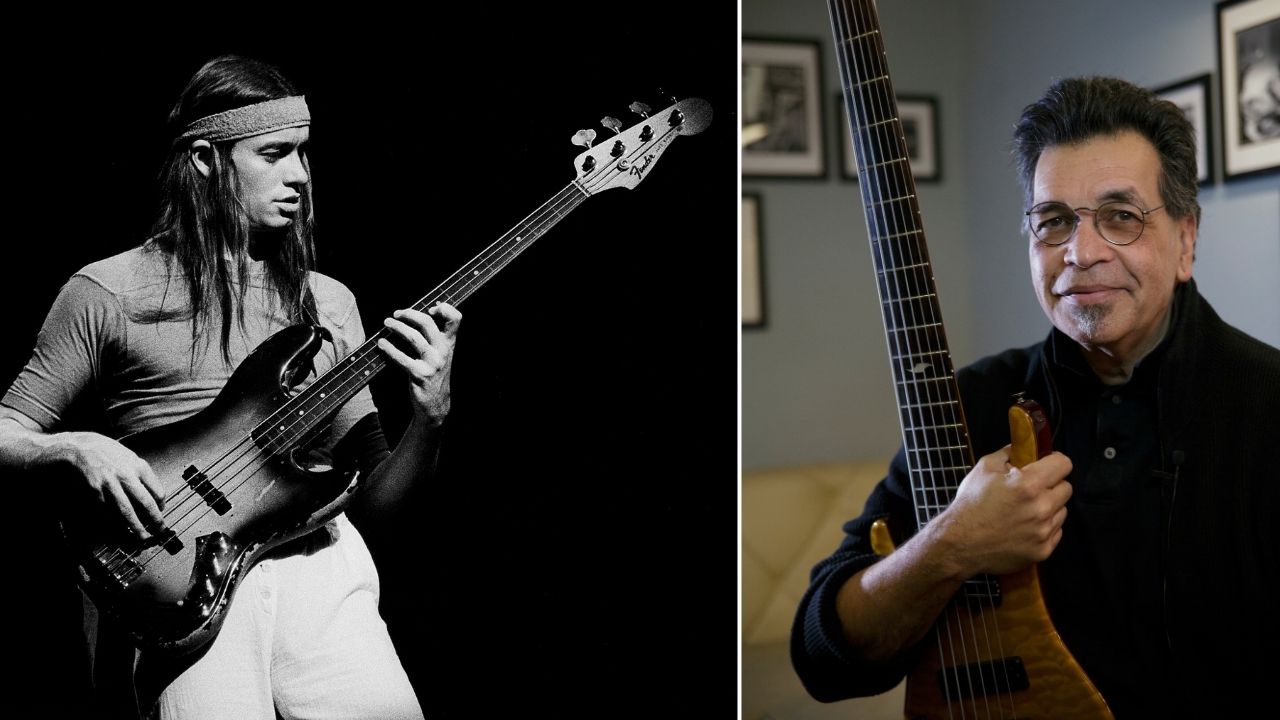Quicksand's Walter Schreifels: "I love playing expensive things, but I'm also totally down for street-level garbage!"
The post-hardcore vet on his love of Fender offsets, switching up his playing for new album Distant Populations, and why he named a song after the MXR Phase 90

Quicksand guitarist-vocalist Walter Schreifels is a long-distance runner. Metaphorically, you could apply that to the sterling musical journey Schreifels started while playing guitar and bass, respectively, with ‘80s New York hardcore icons Gorilla Biscuits and Youth of Today, laying the foundation for groove-forward post-hardcore after forming Quicksand in 1990, through to well-regarded runs with Rival Schools and the bluesier Dead Heavens, among other projects.
On a literal level, he also loves a good jog – evidenced recently when the musician modeled a line of Sonic Youth running gear while dashing through the Lower East Side.
Quicksand, meanwhile, are ramping up for the release of Distant Populations, their fourth album and second since reuniting in 2013. It’s likewise the second collection to feature the slimmed-down line-up of Schreifels, bassist Sergio Vega, and drummer Alan Cage (founding co-guitarist Tom Capone left in 2017).
Following a 22 year gap, 2017 comeback Interiors locked into familiarly hook-heavy stomps (Illuminant) while also broadening Quicksand’s approach with psych-styled, phaser-coursing permutations of post-hardcore balladry (Cosmonauts).
Distant Populations also features those gentler moments (Phase 90), but the group’s most recent album is an overall buzzier outing, rife with adrenalized tempo-pushers (Lightning Field), mean-mugging riffs (Inversion), and anxiety-inducing, quarter-note punch-ups (Missile Command).
Two albums into their reunion phase, Quicksand have now released just as many albums as they had during the ‘90s. They’ve well surpassed the nostalgia stage, but even so, Schreifels admits not every fan is willing to go through this evolution with Quicksand.
“You have this thing they love, because it’s in amber. As soon as you fuck with that, you’re automatically going down, because you’re no longer in this magical land of perfection. So, yeah... that’s a risk.”
All the latest guitar news, interviews, lessons, reviews, deals and more, direct to your inbox!
Taking a day of rest from his regular run routine, Schreifels got Guitar World up to speed on the MXR-celebrating soundscapes and “chaotic” leads of Quicksand’s forthcoming Distant Populations.

Did you listen to any early mixes of Distant Populations while running?
“Absolutely! We finished the record in the middle of lockdown, so I had nothing else to do but run, listen to the raw tracks, and think about mixes. I thought about the things that could be turned up, or lowered; I was deep into it.
“Running is definitely when I listen to a lot of music, although right now I’m off of that. If a record can keep your attention as you’re running, that’s a good sign.”
Did studying the record with that different kind of a listening experience reveal anything about the songs that you hadn’t considered before?
“It was just, like, ‘I think that vocal can come up here.’ Nothing amazing, but in just in a general way, I think this record’s good!”
This is the second album of Quicksand’s reunion phase. Did you feel more pressure this time around, or less?
“I felt there was less, to be honest. I think with the first [reunion] record [Interiors], you have this thing, Quicksand, that fans love and have a relationship with – to the records that came out in the ‘90s.
Interiors was more of an expansive record – there’s more effects on it; I feel like it’s more psych-inspired. Inversion just sounds like, ‘Let’s crack our knuckles and do this!’
“You’re kind of fucking with that by putting out a new record. It could feel disconnected to that [early phase] in a way that could alienate fans. I felt that pressure [making Interiors]. Having now gone through that whole thing, you know, it was a very successful thing. I think we really found our voice.
“Having played around the world on [Interiors], we have a better understanding of what we do – what’s good about us from the past, and where we want to go in the future.
“The other side of it is this is not just, ‘Hey, we made this reunion record! Isn’t that cool?’ Now we’re a band; we’re a contemporary group. What do we want to say, and how do we project it out into the future, beyond the nostalgia? I felt this [making Distant Populations] was more fun. We had more of a handle on it.”
What was the song that started these sessions?
“I think the one that really got us, like, ‘OK, this is the mission statement,’ is Inversion. Interiors was more of an expansive record – there’s more effects on it; I feel like it’s more psych-inspired.
“Inversion just sounds like, ‘Let’s crack our knuckles and do this!’ It hearkens back to some of our earlier stuff, like that initial idea of what Quicksand would be, but at the same time it’s contemporary and honest to ourselves, to the time that we’re living in.
“After that song came together, I felt confident with every other aspect of the record. The record isn’t all like Inversion; it’s got a lot of different looks, but I felt confident going into those [other directions] based on this very simple song.”
That lead riff on Inversion locks into one of the album’s leaner, nastier grooves. There are some atmospheric moments on the record, like with Brushed and Phase 90, but overall it feels like a heavier record than Interiors. Could you sense that it was going in a more aggressive direction?
“For sure. We wanted to do that. Of course, what makes the record great are songs like Brushed or Phase 90, but I think what kind of energizes [the album] is how they contrast songs like Inversion or Colossus.
“Heaviness is a part of what Quicksand is, always. If one of your skills is being heavy, and you’re resistant to that, then that’s a real Catch 22. We wanted to be heavy in a way that suited us, and that we could have fun with.
“When we want to do something more chill, or something nuanced, that’s exciting too. It balances out in a cool way. I think that’s what good bands do. I’m happy with how we hit those notes.”
The title to Phase 90 is a reference to the MXR pedal, right?
“Of course! The Phase 90 is one of the ultimate pedals. Beyond the wah-wah, it’s the most ‘70s, yet futuristic pedal you could have. It’s the most Star Wars. It’s so iconic.
“Quicksand was very influenced by early shoegaze stuff. Like, we were just eating up My Bloody Valentine early on – these bands from England that were reconfiguring psychedelic music for the ‘90s era. We just ate that up.
“The Phase 90 is a real starter kit with that. It has a dope name. It’s orange. There’s just something magical about this little rectangular box. And with the name, I don’t know... taken out of context, if you’re not a guitar player, [Phase 90] could mean a lot of different things.
Especially with recording as a three-piece, I had to expand on my style. I had to create space. I got more interested in effects. I had to pick my spots differently. And my playing just got better
“The first song on our album Slip [Quicksand’s 1993 debut] is called Fazer. Of course there are certain qualities that you hold onto that define your understanding of who you are, but you’re [also] going through different phases [all throughout] life – even within a week, or within a day.
“A Phase 90 is an awesome, metallic, electronic manifestation of that. That’s what it means to me... and it’s also just one of the coolest pedals of all time.”
With that idea of evolution in mind – and with respect to your own gear list – did you go through any major changes with your set up between Interiors and Distant Populations?
“Especially with recording as a three-piece, I had to expand on my style. I had to create space. I got more interested in effects. I had to pick my spots differently. And my playing just got better.
“As far as gear goes, I play a lot of Fender guitars. I love Fender guitars; a lot of offsets. I also use a Harmony Bobkat with gold foils on it that I really like as kind of interesting, ghostly sound – coming from some other realm.
“I just think gold foil pickups are so awesome. They have such a ghostly quality to them, so if you use it in a heavy context, it sounds atypical. It’s a very subtle thing. I mixed that with some more modern sounds, too.
“With my overdubs, I used this practice amp. I don’t know who makes it – it’s not a Crate – but it’s a cube-shaped practice amp, and it has these awesome presets. I didn’t have to plug anything else in; I just flipped through the presets. That’s probably the lowest technology level available – I think the amp costs $120, or something – but it’s how you use that magic.
“How do you use what you have, you know? It’s always about the player, the choices that you make, and your tastes; that’s what everything boils down to. Of course I love playing cool shit and expensive things, but I am also totally down for street-level garbage [laughs].”
Brushed, in particular, puts a lot of tremolo effects and acoustics to use. What were you playing, first off?
“I don’t know the model, but it’s a Fender acoustic; I think it was Sergio’s. The tremolo was something that our producer, Will Yip, put on the guitar. I don’t think it was a pedal; I think it was some sort of plug-in he had. At first I was like ‘Shit, I don’t know. We might have some trouble syncing this up live,’ but I think it works. It’s got an iconic sound to it.”
The intro to Katakana has these dub-like clinks and delays surging through it. Was that live pedaling, or were those true dub-style production touches done after the fact?
“That’s live. I use an MXR Carbon Copy. It’s one of my go-to pedals; just a workhorse. It sounds fucking awesome, and I know how to use it. Only three knobs!
“I loved the Edge as a kid; I loved what he did with delays. It’s just a magical thing. Or I think about Jimmy Page hitting the bow on the Les Paul and sending this delay-shaped sound out to Madison Square Garden. He’s a wizard! That’s just me fucking with [the Carbon Copy]. It’s very simple, but I think it sounds trippy as hell.”
What do you think is the trippiest performance on Distant Populations?
“There’s one guitar solo on the record, on EMDR. I think my solo sounds really chaotic, but it’s all perfectly placed, and played to the top of my ability. It serves its purpose perfectly.
“I really love a guitar player named Tim Presley, he records as White Fence. He is such a cool guitar player; I love his laid back style. He’s a very good technical player, but he also has a good sense of how to play simple things well. I feel like I’m grabbing a couple of plays from his book.
“I don’t have the technical skill to really lay it down in a way that’s, like, ‘Damn! That’s super-tight!’ It’s more about the ideas behind it. So I think, to me, that’s the trippiest moment: ‘Look at me, I’m playing this lead!’ It’s kind of bad, but it’s perfectly bad – like in a good way.”
- Distant Populations arrives August 13 via Epitaph.
Gregory Adams is a Vancouver-based arts reporter. From metal legends to emerging pop icons to the best of the basement circuit, he’s interviewed musicians across countless genres for nearly two decades, most recently with Guitar World, Bass Player, Revolver, and more – as well as through his independent newsletter, Gut Feeling. This all still blows his mind. He’s a guitar player, generally bouncing hardcore riffs off his ’52 Tele reissue and a dinged-up SG.

